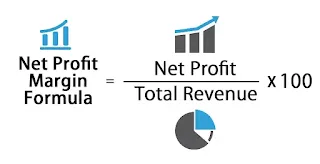Net Profit Margin: How To Calculate Net Profit Margin
It is very important for small business owners to know how to calculate net profit margin to have a better understanding of their financial health.
What Does Net Profit Margin Say About A Company?
Net profit margin measures how much of a business’s sales is real profit, after deducting cost of goods sold (COGS), operating costs and taxes. It shows the ratio of net income to revenue and provides insights into a company's overall profitability.
Net profit margin differs from gross profit margin, the latter only measures revenues after the cost of goods sold, without adding any other costs. We calculate net profit margin from a business’s income statement, which looks at the revenues, expenses and overall profit or loss a business generates over a specific period under review.
Generally, companies with a higher profit margin are in a better financial position than companies with lower income margins. Small business owners should know how to calculate net profit margin to check whether their strategies are impacting positively or negatively on the company’s bottom line.
How Do You Calculate Net Profit Margin?
Firstly, look through your business’s income statement and note your revenue or total sales. Then, calculate your net income by deducting the items below from your revenue:
- COGS
- Fixed costs
- Interest
- Tax
- Dividend payments (if your company pays stock dividends)
Finally, divide your net income by total revenue and multiply the answer by 100 to express net profit margin as a percentage.
Net profit margin formula
Here is the net profit margin formula:
Net Profit Margin = (Total Revenue – Total Costs) / Revenue x 100
Or
Net profit ÷ Total Revenue × 100
Net Profit Margin Calculation: example
This sample net profit margin calculation can help you better understand how to calculate net income margin. Most of these calculations are already prepared on your business’s income statement, but going through all the steps helps you better understand the meaning of net profit margin and how to calculate it.
For instance, in 2018, company ABC sold 50,000 units of its product at a cost of $10 per unit. The cost of goods sold (COGS) for the product was $6 per unit. The company’s total operating expenses for the year is $25,000 and taxes is $30,000.
Step 1: Firstly, we will find the company’s total revenue, we can calculate this by multiplying the number of units sold by the cost per unit.
Revenue = 50,000 x $10
Revenue = $500,000
Step 2: Secondly, we calculate net income by deducting from the total revenue the COGS, the operating expenses (fixed costs) and taxes. The cost of goods sold in this case is $6 x 50,000 units, or $300,000.
Net income = 500,000 – (300,000 COGS + 25,000 operating expenses + 30,000 taxes) = 500,000 – 355,000
Net income = 145,000
Step 3: Lastly, to calculate net profit margin of company ABC, divide net income by revenue and multiply by 100.
145,000 / 500,000 = .29 X 100 = 29%
Net profit margin = 29 percent
What’s the Importance of Net Profit Margin?
Net profit margin is an important indicator of the financial health of your business because it tells you the real profit you’re generating from your sales after subtracting all your expenses. Hence, it tells you how profitable your enterprise is. A company's management can track its net profit margin over time to see if current strategies are working and improving the bottom line. It also helps you to forecast profits and plan for your business.
If you are looking for loan for your small business, lenders will check your net profit margin before determining whether to lend you money or not. A company with a healthy net profit margin is more attractive to lenders, because a strong profit means you probably have a healthy cash flow and are less likely to default on your debt.
What Is a Good Net Profit Margin for a Service Business?
Service business renders service to their customers, they neither sell any product nor buy to resell. Net profit margin is often high for service businesses because they often have lower operating costs than in other industries. The simpler business structure you have, the higher your profit margins because you will have a lower expenses. If your service business is a sole proprietorship with no employees, you don’t have the expense of worker salaries. And if you are running your service company from a home office, costs like rent, utilities and insurance are lower than for more businesses outside the industry.
Also Read:












